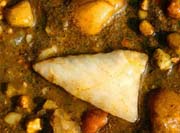 |
Earth Journal by Gary Pendleton |
Messenger from Times Past
Quartzite Spear Point
A sunny winter afternoon, not too cold, made a great day for a walk. The woods were quiet. At the water’s edge was a nice surprise: Low tide exposed acres of flat mud. The shores of the Patuxent are a good place to look for Indian spear points, but I had never found one.
The chipped, triangular, white quartzite stone lay on top of the flat mud. Surrounded by smaller, rounder, multi-colored pebbles, it stood out like a giant among school kids. It looked as if it might have been left in that spot only a few minutes before my arrival.
It appears to my untrained eye to be in perfect shape; the edges are sharp and it has a nice point. Reddish-brown clay silt stains the fine cracks on the surface of the ancient tool, but otherwise the quartz shines as if it were waxed and polished. It is about one and three-quarters by one inch, nearly symmetrical with a slightly concave base. It is beautiful. Awesome is a word that has been overused in recent years, but I can’t think of a better word to describe what it feels like to hold it in my hand.
I let my imagination run, wondering how long it lay there and how it landed in that spot. Who made it? Where did the stone come from? Was it local? Who used it and how did it come to be lost?
The story of what happened to the people who made the spear points is a great human tragedy. Other stories relate to the skill it took to make and use this one little stone tool. There is a story about where the stone was found and how it was carried to the shores of the Patuxent. There are stories about the love the people had for their way of life, their culture, their families and the place they lived. They are stories that make me feel connected to this part of the world, even if I never hear them told.
As spear points go, this one might not be that old. It appears to be a type called Madison, which was used by Late Woodland period Indians. Use of the Madison point began about 900 years ago and continued until the time of European contact.
The spot where I found the spear point is about 10 feet from the usual high tide zone. My guess is that it washed out of the high bluff above the shore. The bluff and shore are not private property; they are county owned.
Now, I want to hold it in my hand a few more times, admire the skill with which it was made and listen to the stories.
